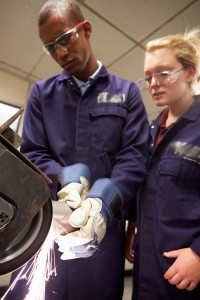As a Human Resources professional, I’ve spent a great deal of time walking the floor, in factories and in office areas. When I first  started ‘taking the pulse’ this way, it was simply to learn people’s names, their jobs and skills and to better understand the business at a high level. But I found that as I continuously improved my chats, I learned a great deal about the organization that helped me to make a real impact on people and the business. In fact, I do this as a professional specialty now.
started ‘taking the pulse’ this way, it was simply to learn people’s names, their jobs and skills and to better understand the business at a high level. But I found that as I continuously improved my chats, I learned a great deal about the organization that helped me to make a real impact on people and the business. In fact, I do this as a professional specialty now.
Management books from long ago espoused the value of “management by walking around” and in Lean there’s a practice called “Genta Walks”. These are similar, but not identical, to my walk-around practice. I’ve decided to share it not only with other HR people but also with managers and executives who are curious about what their people are doing and what they experience during their workdays.
What do I learn from my walk-around practice?
- The culture of the organization
- How and how much people interact as they complete their work including interdependencies, how they talk to and respond to one another, frustrations they encounter in the course of getting things done, and how they feel about their jobs
- What people are focused on while at work
- Management and leadership styles
- What meetings are held, interpersonal dynamics of those meetings, results of meetings
- Obstacles our systems create for people in getting things done
- How many employees have lots of ideas to improve their work, work processes, layout of work areas and tools
- How engaged people are
- How well people understand the reasons for changes.
- The understanding people have of metrics.
My learnings have enabled me to work with management in driving improvements. Following are a few examples:
- Reduction of waste such as scrap, time, and material
- Improvement of quality and on-time shipping
- Delivery of min-trainings on metrics and incentive plans
- Building and sustaining higher employee engagement
Do you feel it would be beneficial to managers in your organization to gain these insights? Do they have the time and the skills to implement and sustain an effective walk-around? Do you? Following are 5 principles of a powerful walk around work practice:
1. Start Gently
- Establish a non-threatening, friendly and interested presence.
- Begin with short chats as you pass by. Show interest in what individuals do.
This helps you to develop a rapport and approachability. Once you have that, you can begin to ask other questions.
2. Pay Attention
- Always treat people with warmth and respect.
- Relax.
- Don’t take or make phone calls while you’re with someone.
- Always smile and say hello to people you visit and those you pass by. Learn their names quickly. Then learn what they do.
3. Dig in
Once you have built a rapport, ask questions. Remember – they are working, so make each visit short and related to the individual’s job. Time will likely permit you to ask each person only one question after chatting briefly. Good questions will come to mind if approach it with the end in mind — knowing what you want to learn as a result. Following are a few examples of questions you might ask people:
- I’d like to understand your job; could you possibly explain what you’re doing?
- I understand we recently changed (x); what are your thoughts on that?
- What changes would you make if you could, that would make your work easier or faster?
- Can you tell me how this gets made? What happens before you get involved, and after you do your part?
- What is the purpose of (that step)?
4. Show appreciation
- Thank people and let me know you enjoyed talking with them at the end of each visit.
5. Be reliable
- Always bring one of those tiny spiral notebooks and a pencil with you to take notes when appropriate i.e. when someone talks about an idea they have for improvement or brings up something you can address for them (if they wish).
- Be certain to get back to someone promptly if you take an action item. You’ll lose their interest if you let them down.
- Be discreet when sharing information you obtain with others. Get permission first.
I find it helps to schedule walk-arounds in my calendar like meetings. That way people learn to expect me to show up regularly. Don’t overcommit your time or you’ll end up cancelling walk-arounds.
Establishing and sustaining an effective walk-around practice is not easy to do. It takes time and commitment. Most people will not be able to make this part of their work routine. If you do it well, there’s value in it for the people, you, and the business.
Will you be implementing a walk-around practice? Please write back to share your experiences and the benefits.
Latest posts by Rosanna Nadeau, PCLEC (see all)
- Is Quality Being Lost In Today’s Quest For Efficient Execution? - August 31, 2023
- What is HR’s Strategic Role? - August 24, 2023
- Agility: The Ability to Zig and Zag - August 23, 2023












